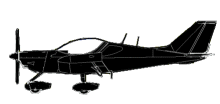
ASN Wikibase Occurrence # 206485
This information is added by users of ASN. Neither ASN nor the Flight Safety Foundation are responsible for the completeness or correctness of this information.
If you feel this information is incomplete or incorrect, you can submit corrected information.
| Date: | Friday 4 August 2017 |
| Time: | 08:00 |
| Type: |  CZAW SportCruiser |
| Owner/operator: | Nmg Aviation Llc |
| Registration: | N777NG |
| MSN: | 07SC059 |
| Year of manufacture: | 2007 |
| Total airframe hrs: | 2593 hours |
| Engine model: | Rotax ROTAX 912S (4 |
| Fatalities: | Fatalities: 0 / Occupants: 1 |
| Aircraft damage: | Substantial |
| Category: | Accident |
| Location: | Salisbury, NC -
 United States of America United States of America
|
| Phase: | Landing |
| Nature: | Training |
| Departure airport: | Salisbury, NC (KRUQ) |
| Salisbury, NC (KRUQ) | |
| Investigating agency: | NTSB |
| Confidence Rating: |
The student pilot reported that he had departed with the intent to perform touch-and-go takeoffs and landings. After takeoff, he realized that the canopy was not latched. He struggled to maintain airplane control in the pattern, but he was able to land normally.
The student pilot then checked the latch handle, and he believed that he had secured the canopy correctly. He took off and flew one pattern but just before landing, the canopy opened and obstructed the pilot’s view of the runway.
The airplane landed hard and bounced, and the pilot aborted the landing.
The student pilot flew a third pattern and made an approach over the runway centerline, “slightly above stall airspeed.” The airplane landed hard on the runway, and the right main landing gear (MLG) and the nose landing gear separated from the airplane. The airplane skidded to a stop on the runway.
The airplane sustained substantial damage to the right MLG attachment points and the right-wing spar.
The student pilot asserted that the canopy latch was down during the takeoffs but was not seated correctly. For the latch to seat correctly, “the canopy itself needed to be pushed up so that gravity seated the canopy.”
The airplane was equipped with a full-width clear canopy, hinged in the front and tipped forward for entry to the cockpit.
The manually operated canopy was supposed to be closed by the pilot by reaching above their head and grabbing the handle identified by the manufacturer’s illustrated parts catalogue as SF0730N. Per the photographs provided by Federal Aviation Administration (FAA) aviation safety inspectors, the handle was not installed on the canopy.
The canopy security latches consisted of two metal claw-type latches that were mechanically moved forward to secure the canopy to the fuselage. The canopy latches were moved forward to the secure position when the pilot lowered the canopy “T” handle. The “T” handle was affixed to the baggage compartment front wall in the cockpit between the left and right seats just above the arm rest and just below the pilot headset audio input jacks.
The student pilot’s head set control unit was about 4 inches long by 1 inch in diameter. Photographs taken shortly after the accident and provided by FAA inspectors revealed that the control unit was lodged underneath the “T” handle.
The student pilot reported that there were no preaccident mechanical malfunctions or failures with the airplane that would have precluded normal operation.
Probable Cause: The physical interference of the student pilot’s headset control unit with the canopy, which prevented the canopy latches from seating properly and resulted in the canopy opening in flight and the subsequent hard landing.
Accident investigation:
 |
|
Sources:
NTSB
Location
Revision history:
| Date/time | Contributor | Updates |
|---|---|---|
| 22-Feb-2018 19:39 | ASN Update Bot | Added |
Corrections or additions? ... Edit this accident description
The Aviation Safety Network is an exclusive service provided by:


 ©2024 Flight Safety Foundation
©2024 Flight Safety Foundation